I recently wrote an article about my favorite fungi stories and now it’s time for the companion piece about sentient (and often sinister) plants. It’s a common misconception that fungi are plants, but they’re biologically very different. While plants make their own nutrients via photosynthesis, fungi decompose matter in order to survive. And although fungi might look like they belong to the vegetable category, on a molecular level they’re actually more closely related to the animal kingdom.
But don’t be fooled into thinking that plants are any less creepy than mushrooms just because they like sunshine and share less DNA with us! For instance, a recent study found that plants emit ultrasonic screams when they’re underwatered or cut. With that unsettling thought in mind, let’s dive into seven stories (that are thankfully fictional… at least for now) about scary plants.
The Ruins by Scott Smith
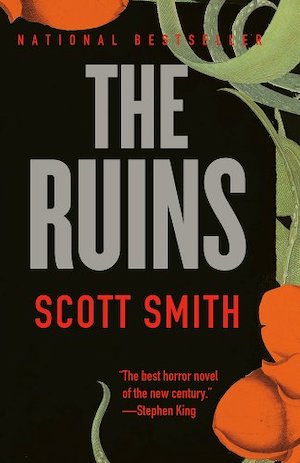
Survival horror tends to lend itself to exhilarating plots that barrel forward without pausing for breath and The Ruins (2006) definitely fits that bill. There are no chapters; instead, the book is presented as one continuous narrative which makes the horror feel relentless. There are small breaks when the POV shifts between characters, but I found myself desperate to read on, while simultaneously being repulsed by the gore.
The story follows a group of ill-prepared (and, honestly, idiotic) young adults who wander into the Mexican jungle looking for a good time (under the guise of searching for a missing person) but instead find a very, very bad time. Local villagers use force to trap them on a large hill surrounded by bare earth, and they’ve only got limited food and water. But both of these problems pale in comparison to the danger posed by the vines that cover the hill, which might just have a taste for human meat.
The Ruins has fun horror vibes, rather than psychologically traumatizing ones—think Cabin Fever (2002), rather than Hereditary (2018). If you prefer to experience this kind of horror onscreen, then a movie adaptation (which changes things around, so there will still be surprises even if you’ve read the novel) was released in 2008, but Smith’s descriptions in the book manage to be even more gruesome than the onscreen visuals.
Semiosis by Sue Burke
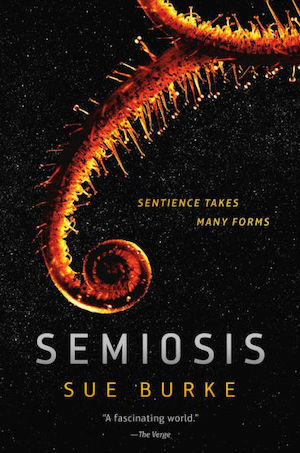
First contact narratives usually offer up humanoid or animal-like alien life forms, but Sue Burke takes the road less traveled in Semiosis (2018) by imagining a planet where the flora is more intelligent than the fauna. A small group of intrepid and idealistic explorers have left a failing Earth in the hope of establishing humanity on a new planet. They make an unexpected landing on a world they name Pax and quickly realize that the plants of this planet are considerably more advanced than on Earth.
The narrative unfolds over the course of many years and generations. Building a new society is challenging (and in this case requires a trigger warning for rape and violence) even without the intelligent plants, but interspecies communication and cohabitation adds another layer of complexity. Things are definitely a bit more sinister than, say, Merry and Pippin’s wholesome friendship with Treebeard in The Lord of the Rings.
If you’d like to read an excerpt, then the start of the novel can be read right here on Tordotcom. There are also two short stories that are set within the time period of Semiosis: “Cinderella Faraway” and “Spiders.” A sequel called Interference followed in 2019 and Usurpation, the third novel in the trilogy, is coming in 2024.
“The Seed from the Sepulchre” by Clark Ashton Smith

First published in 1933 in Weird Tales, “The Seed from the Sepulchre” is a short and sharp tale about an ill-fated adventure undertaken by two rare orchid hunters. Along with two guides, James Falmer and Roderick Thon are following the course of the Orinoco River in South America, but they’ve heard rumors of a ruined burial pit that is home to vast treasures and decide to see if the legend is true. Thon becomes ill on the journey and has to stop to rest, but Falmer ventures onward. He finds the tomb, but instead of gold he comes across a strange plant that has threaded its roots around the bones of the residents. What follows is some delightfully disgusting Cronenberg-level body horror…
The Day of the Triffids by John Wyndham
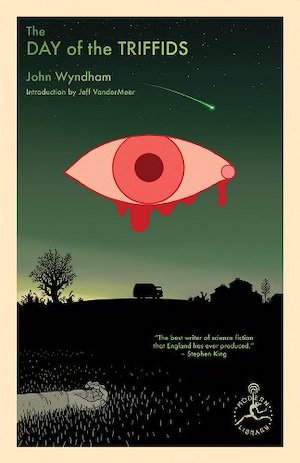
John Wyndham understood that it wouldn’t take much for society as we know it to unravel and he demonstrates this terrifying truth in The Day of the Triffids (1951). One day a strange new plant appears; it is tall, venomous, and can uproot itself to move around. Oh, and it’s carnivorous. Think Audrey II from Little Shop of Horrors but with a little less conversation and a little more locomotion. Despite their obscure origins and hunger for meat, humans think they can control the triffids and decide to milk them for all they’re worth, which in this case means harvesting the valuable oil they produce.
Then a beautiful meteorite shower blinds the vast majority of the population and suddenly humans aren’t at the top of the food chain anymore. Like many post-apocalyptic stories, The Day of the Triffids also dives into the idea that humans are the real monsters, offering social commentary on one hand and exciting action on the other. The story has been adapted many times, but honestly none of the versions I’ve seen outdo the original novel.
The Book of Koli by M. R. Carey
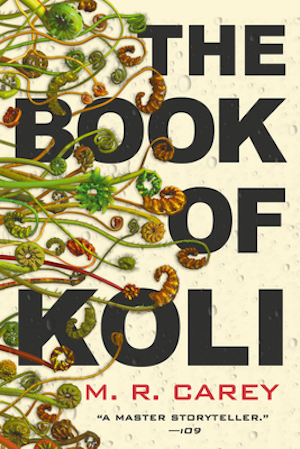
The Book of Koli (2020) is the first installment in M. R. Carey’s Rampart Trilogy, which is set in a far future where genetically altered plants have grown out of control and are now viciously aggressive towards humans. There are only a few pockets of civilization left, and the few pieces of technology that have survived the plant-pocalypse are treated as highly-prized magical objects.
Protagonist Koli lives in a small and relatively safe community called Mythen Rood, but if Twin Peaks has taught us anything, it’s that small towns often hide big secrets. When Koli starts to realize that not all is as it seems in Mythen Rood, he’s cast out into the deadly wilderness and left to fend for himself.
Carey’s novel is set many years in the future and the language used deviates slightly from standard English so it can take a little while to get used to. For instance, Koli says that he lives in Ingland (England), but that it also used to go by Briton (Britain), Yewkay (UK), and Albion (he gets the spelling right with that one). As well as spelling variations, his conjugation and grammar can also be clunky and odd at times, but it’s well worth adjusting to the language drift in order to explore the incredibly rich world of bizarre botanicals that Carey has created.
“Weeds” by Stephen King

The short story “Weeds” is probably better known in its adapted form as a segment in George A. Romero’s anthology movie Creepshow (1982), titled “The Lonesome Death of Jordy Verrill.” Stephen King served as the film’s screenwriter and based two of the segments on his own short stories. Best of all, King himself stars as the hilariously dim-witted Jordy. His son, future horror writer Joe Hill, also got the chance to act in Creepshow, playing the horror-loving young boy in the prologue and epilogue.
Jordy isn’t the brightest and he’s clearly never read H. P. Lovecraft’s “The Colour Out of Space,” because when a meteorite lands on his farm he decides to touch it. First he gives it a kick with his boot (which isn’t so bad) but then it splits open and he pokes the weird contents with his fingers (which turns out to be a very bad move).
The original story was published in 1976 in Cavalier and was reprinted in 2014 when it appeared in the anthology Dark Screams: Volume One, but it hasn’t been included in any of King’s own short story collections and so is sometimes overlooked.
“The Willows” by Algernon Blackwood
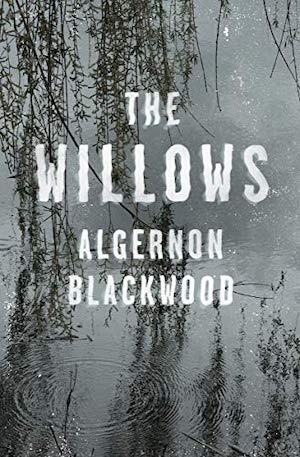
Algernon Blackwood’s 1907 novella “The Willows” takes what should have been a pleasant canoe trip down the Danube and turns it into the holiday from hell. Two friends are boating down the river when a storm blows in and traps them on a small island. They’re surrounded by willow trees, which not only seem to have minds of their own, but don’t even seem to be of this world. Rather than blood, guts, and gore, Blackwood focuses on atmosphere, mounting tension, and terror. The classic story served as the inspiration for T. Kingfisher’s The Hollow Places, bringing readers back under the spell of Blackwood’s haunting willows while putting her own uniquely terrifying stamp on the tale.
***
The stories above are some of my favorite examples, but hardly an exhaustive list—feel free to drop your own recommendations for plant fiction of the strange and/or scary variety below!
Lorna Wallace has a PhD in English Literature and is a lover of all things science fiction and horror. She lives in Scotland with her rescue greyhound, Misty.










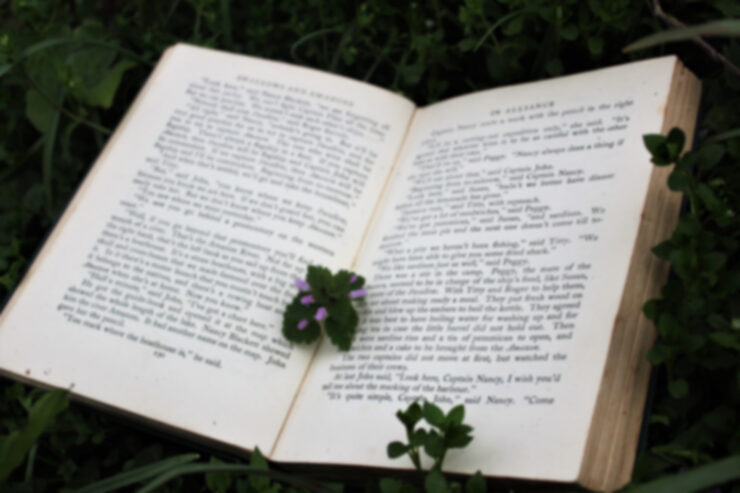
Green er Than
er Than 
 You T
You T hink by War
hink by War d Mo
d Mo ore.
ore. 
Love this! I also recommend “Strange Horticulture” for PC and/or Nintendo Switch. The plants aren’t really sentient, but they’re mysterious and sometimes dangerous. You play as a shopkeep who has to find and label plants to cure specific ailments or solve specific problems. It’s sort of escape-roomy and cozy at the same time. Solid for botanic fanatics!
The Donovan series by W. Michael Gear contains and absolute plethora of scary plants!
I just reviewed one such story! Clifford Simak’s Ogre (1944). Human star merchants trade with intelligent plants. Both sides have bold ambitions to assist the other side to better serve them. Oddly–OK, not so oddly given that it is Simak–everyone, plant and human, talks like they are from Wisconsin, except one beatnik plant.
Hothouse (aka The Long Afternoon of Earth) by Aldiss didn’t make the list? Say it ain’t so!
I don’t have a book to share, but that fact about plants screaming is very upsetting. I’ll never forget to water or use scissors to trim again. Yikes.
“ The Reluctant Orchid” by AC Clarke. A large, carnivorous, orchid may solve our hero’s trouble with his overbearing aunt
Edmond Hamilton’s story “Alien Earth” features perfectly ordinary plants – and a drug which slows down human metabolism to the point where people live at the same pace as the plants. It’s a memorable and unnerving piece.
Murray Leinster’s “Proxima Centauri” has a generation ship land on a world of intelligent, carnivorous plants.
Cleopatra, Morticia’s pet carnivorous plant from the original “The Addams Family” tv series, is definitely on my list.
Regarding the Triffids, Wyndham implies that they were developed as a genetically modified species in the USSR and when their developer tries to escape with the seeds, Soviet air defence shoots his plane down, the seeds are scattered into the upper atmosphere, then fall to earth over time and throughout the world (which is why they start growing about the same time but in a range of locations). And the “meteorite shower” which blinds most of the world is also implied to be man-made via a satellite-borne weapon, though whether it’s a deliberate attack or a mistake is never investigated.
Very good list, I like the variety of eras and genres.
The new Star Wars High Republic books introduced the Drengir to the universe, a race of plant-like beings with a hive mind. Into the Dark by Claudia Gray was quite a creepy little tale, set on an infested and abandoned space station.
An honorary member of this list should be “What Moves the Dead” by T. Kingfisher, which deals with fungi rather than plants…
Regarding the Triffids, Wyndham implies that they were developed as a genetically modified species in the USSR and when their developer tries to escape with the seeds, Soviet air defence shoots his plane down, the seeds are scattered into the upper atmosphere, then fall to earth over time and throughout the world (which is why they start growing about the same time but in a range of locations).
This is explicitly stated in the book, if I remember – they were bred to produce edible oils in newly-exploited farmland in Siberia.
And I’ve always liked the implication that, shortly before the book starts, the following conversation presumably happened in a small office in the Agricultural Experimental Establishment Number 83 Named After Academician V. K. Komarov:
“Comrade Doctor! What progress with the oil crops?”
“Well, mixed progress, to be honest, Comrade Director. We had high hopes of Strain A-341, which produces 2.73 tonnes per hectare, but it requires high levels of nitrogenous fertilizer. And Strain K-22 has an excellent yield of 2.81 tonnes per hectare, with only minimal fertiliser required on particularly poor sandy soils, but the yield declines sharply when night-time temperatures drop below minus 3 degrees, which limits the growing season and the geographical range. …And then there’s Strain T-9, which produces as much as 3.01 tonnes per hectare with very good cold tolerance and no need for fertiliser at all, but it turns out that the reason it doesn’t need fertiliser is that it has a habit of hunting and killing agricultural workers with its terrifying poisonous tentacle and then slowly eating their decomposing bodies.”
“Oh, I wouldn’t worry about that too much. Plenty more where they came from! Ha ha ha!”
“Very true, Comrade Director! Ha ha ha! Full-rate production for Strain T-9, then?”
“Absolutely! We’ll have ten thousand hectares of the Khabarovsk Oblast ready for harvest by this time next year!”
a huge +1 for Semiosis and Interference. a really unique and engrossing tale of what human contact would be like from both sides. terrifying, but also kind of a comfy read.
and +5 for seeing there is a third book coming.
See also The Lotus Caves (1969) by John Christopher. Set on a colonized Moon, two teenage boys steal a “crawler” tractor and go exploring on their own, eventually crashing into a cavern inhabited by strange plants, which seem to all be connected to one central intelligence. While there, they find a lost lunar colonist, missing for 70 years, who appears to not have aged, and to have little or no curiosity about them. While enjoying the “hospitality” of the caverns (specialized plants provide air, food and even play music), they begin to realize that the “Plant” is sapping their free will and motivation, forcing them to decide whether to stay and enjoy endless comforts at the cost of their identity, or to return to the colony with its limited resources and strict rules, and remaining themselves.
not scary plants but scared ones… Crowley’s plants in Good Omens
i can’t recall the name, but there was an episode on either Twilight Zone or Outer Limits in ’70’s or early ’80’s about a guy who was experimenting on plants. his wife came in one day & put on headphones & they “told” her he & his secretary were having an affair & so she killed them
I know it’s a different genre but:
“Feed me, Seymour. Feed me NOW!”
Yes, folks, it’s Little Shop of Horrors!
Original film (Hello, young Jack Nicholson!), the Broadway musical, or the film musical.
@13 That doesn’t sound too improbable a conversation in Stalin’s time, when Day of the Triffids was written, so long as the workers were Zeks. Although any awkward incidents would probably be hidden from the bosses anyway, so long as the quota could be met. The Soviet Union was not without its incentive schemes.
There are a number of stories in which plants and animals are equally out for blood; see Harrison’s “Deathworld” books, or Colin Kapp’s The Survival Game. However, there’s at least one work which inverts the trope; in McKenna’s “Hunter, Come Home” a vicious clan of humans (think of Julian May’s Tanu, only worse) is trying to clear enough land on an “uninhabited” planet to stock with their apex huntable animal — but the plant life keeps coming back. It’s not traditionally sentient, but has something that might have been called Gaea-style awareness/symbiosis if the term had been popular in 1963.
Ursula LeGuin’s “Vaster Than Empires and More Slow.”
John Brunner’s Pollinators of Eden (1969, i think?) and Caitlin R Kiernan’s The Red Tree (2010).
(The Brunner has had some lovely covers in its various editions.)
“The Family Tree” by Sheri Tepper (1998) The plants are fighting back. Great storytelling.
I can’t believe John Collier’s “Green Thoughts” didn’t make the list.
21: John Boyd, not John Brunner, I believe.
Another fantastic novella in this ilk is “Come Back to the Swamp” by Laura Morrison. Just the right mix of nerdy and creepy.
Jack Vance in the Star King described a world that was populated by a single organism that had animal and plant components.
I read Kit Reed’s short story collection Other Stories and Attack of the Giant Baby in the early 80s but “The Vine” haunts me to this day.
I want ro support the suggestion of Ursula LeGuin’s “Vaster than Empires and More Slow”. An often overlooked early work of hers. I would also mention her short novel The Word for World is Forrest which depicts a largely forested world, and a native species that has adapted to it. The focus is more on the roughly mammalian sentients than on the plants, however. Which reminds me of Alan Dean Foster’ novel Midworld and its sequel Mid-Flinx, in which the very tall and dense rain forest of the planet Midworld is a major focus.
Post 26 mentioned Jack Vance’s The Star King. I would mention his The Son of the Tree, in which a single immensely tall tree is th focus of a planet-wide religion. Vance also wrote The Houses of Iszm in which genetically engineered plants serve as the perfect houses. Provided that you can get a fertile seed, as the owners will only sell sterile ones to keep up the market. That novel may have inspired Leo Frankowski’s Copernick’s Rebellion, which also deals with bio-engineered trees as living quarters.
The fist story in David DCrakes “Lacey”series (AKA “Nation without Walls”) dealt with murder by houseplant.
And let’s not forget that old SF filksong classic “Beware of the Sentient Chili”.
Alan Dean Foster’s Midworld has humans on a forest planet who have a symbiotic relationship with a hexapedal lical lifeform that’s a sort of mobile plant, the sessile stage of which is used in their burial practices.
While the book isn’t specifically about scary plants, “Sweep of the Heart,” by Ilona Andrews, features the Dushegubs. These are mobile tree-shrub alien creatures, which are described by the main character as sapient, not sentient – they know that other creatures have feelings and are intelligent, they just don’t care. All they are interested in is pursuing their own goals, and everyone else is just fertilizer.
Didn’t H.G.Wells have a short story about a blood-sucking orchid?
WRT triffids: I am a huge fan of the book, especially the original edition (it was shortened for the U.S. market). I am such a nerd, though, that I worked out what would happen to triffids after the end of the story. I won’t put all the details here, but one important thing that would not have been clear to British researchers in particular is just how many animals would find triffids both delicious and accessible. Animals that were too low to the ground for triffids to sting. Animals that were too hairy or well armored to be poisoned. Animals that were just too big to bring down unless they waded into the middle of a triffid mob (and remember that triffids are very slow). Anything in any of these categories that liked to eat roots or juicy, fibrous stems would enjoy a meal of triffid. Wild pigs, tortoises, bears… Elephants, in particular, would seek out and destroy triffids because they could pose a danger to their calves. Bringing the focus back to England, if any pigs survived and got out of confinement, they would find themselves with few predators and a lot of food. ISTR that the book ends only 5 to 7 years after the original world-ending disaster, which wouldn’t be enough time for pigs to spread to every part of Britain; but eventually they would, and they would hunt for delicious, nourishing triffid roots wherever they went.
In terms of songs, there’s “The Return of the Giant Hogweed” by Peter Gabriel-era Genesis, from their 1971 album Nursery Cryme. Found “long ago in the Russian hills” by a Victorian explorer and brought to London, the Giant Hogweed soon spreads out, becoming a threat to the human race out of revenge for its capture.
Didn’t H.G.Wells have a short story about a blood-sucking orchid?
“The Flowering of the Strange Orchid”, published in Tales of Wonder. It has the classic intro of “well, we found this root nestled beneath the mysteriously exsanguinated body of its discoverer, fancy taking it home and growing it?” “Sure, sounds cool!”
And David Langford parodied it with a story about a collector who finds a very similar orchid and hopes to use it to kill his terrible overbearing Wodehouse-style aunt, but the aunt shouts at the orchid and scares it into submission.
one important thing that would not have been clear to British researchers in particular is just how many animals would find triffids both delicious and accessible.
I am not sure why pigs or bears would be immune to triffids. Triffids, in the book, are able to target eyes specifically. Pigs have eyes. So do bears. (Even though I am a British person, this is clear to me.)
And pigs would be more vulnerable, not less, than humans, because they don’t wear clothes. A triffid sting is “capable of discharging enough poison to kill a man if it struck squarely on his unprotected skin” – if it can kill a man, it can kill a pig. It probably couldn’t kill an elephant sixty times the weight of a man, but it could hurt it, even blind it, and the elephant would steer clear of the triffid thereafter. It could kill a tortoise with stings to the head and neck very easily.
Nor am I sure why triffids can’t reach animals close to the ground. A mature triffid’s sting is “a slender stinging weapon ten feet long” and a mature triffid is, at its largest “nearly ten feet high. No European specimen over eight feet had been seen, and the average was little over seven”. A seven-foot plant with a ten-foot sting on its top can certainly reach anything that wanders up to its base and starts munching.
@35: I note that repeated triffid stings, if they don’t kill you, will confer partial immunity, and some breeds of pigs have ears that flop over their eyes, and an adult pig considerably outmasses an adult human.
As for tortoises: The way triffids are described, they don’t have fully mobile stinging tentacles. They can uncurl them with astounding speed and curl them up to lift bits of rotten meat into their pitcher-mouths, but they can’t twist and turn them like an octopus can. Anything within the arc of the uncurling tentacle may be in danger. But a tortoise may be able to trundle along, even with multiple triffid stings slapping at its armored back, to go straight in and munch on the bole. And once it’s right up there, it can’t be reached.
Come to that, tortoises are known to search for carrion to eat. Finding a corpse with a stung-out triffid squatting on it, the tortoise would make the triffid bole a part of its multi-course dinner with minimal danger.
And don ‘t forget that young triffids are not mobile or venomous. A bear in a field of young triffids would be extremely happy.
I should think razorback hogs from Arkansas might make fast work of Triffids. They are *mean*.
Let’s not forget the Hogwarts greenhouses, nor the greenhouse in Minority Report (the movie).
But most of all, let’s hope no one takes up the grafting experiment which might result in Audrey Rose…
“some breeds of pigs have ears that flop over their eyes”
This image is hilarious. Thank you!
Unless I am badly mistaken, that is not David Langford, it is one of the Tales From the White Hart by Arthur C. Clarke. The title is “The Reluctant Orchid”. See https://en.wikipedia.org/wiki/The_Reluctant_Orchid
Ironically, the aunt is described as “Wodehouse-style ” but the Whjite Hart stories were admittedly inspired by the Jorkens stories of Lord Dunsanay amn those in turn owe something to Wodehouse’s Mr Mulliner.
@8: Thank you for mentioning that! I read that story in a paperback anthology many years ago and it always stuck with me, but I’d never been able to remember the title or author (or, for that matter, the anthology I read it in, which, from ISFDB, was Alien Earth and Other Stories, from 1969, ed. by Roger Elwood and Sam Moskowitz).
More triffid stuff: It’s implied that they grow more vigorously in tropical areas, which suggests to me that they grow less vigorously the further north you go. This also suggests that if you make them cold they become less individually vigorous, although triffid farms in Siberia most likely mean that they are frost hardy. Imagine vast fields of Siberian triffids, in the pre-disaster days, getting nice and big in the near-endless sunshine, then growing more and more sluggish in autumn until the day comes when it’s (probably) safe to cover their boles in mulch for the winter. If the stems die back, they can regrow.
So there is the least danger from triffids in very cold places (and very dry ones if people or animals can keep the oases clear); more danger where summers are warm, but not so much if there are bears or pigs to eat most triffids before they can walk and less in winter; even more danger in very warm, seasonally wet areas although even there some animals can eat them; and the most danger in the warmest, wettest zones, where they grow rapidly and it’s harder to spot them. Some islands would probably be overrun with triffids, wiping out whole species of birds by stinging them as they came in to land.
Also, the lack of fretting about rats or mice eating up the triffids on their farms suggests to me that rodents don’t like fresh triffid.
I’ve finished reading Semiosis 2 weeks ago. I first heard of the book in a list such as this here on Tor Dot Com… and I must say that except for the bit with the rape, I hardly find the book scary? To me it was more like… fun and cute. Of course there are tense bits, but overall I felt like the cover and synopsis and lists of scary books involving plants were a little overboard.
the lack of fretting about rats or mice eating up the triffids on their farms suggests to me that rodents don’t like fresh triffid.
We spend virtually no time on triffid farms to hear such complaints. Also… doesn’t it equally well suggest that triffids do like fresh rat?
But, yes, rats and mice do not generally eat leaf matter. They’ll eat seeds, though, and would presumably like the oil-rich seeds of triffids – if they could get to them.
Unless I am badly mistaken, that is not David Langford, it is one of the Tales From the White Hart by Arthur C. Clarke.
You are absolutely right! Apologies.